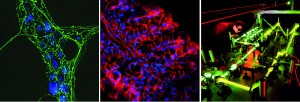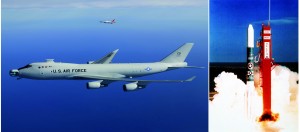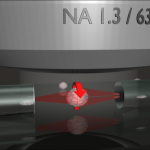MONDAY, 3 MAY 2010
'Dr Evil: Here’s my second plan. Back in the 60s, I had a weather changing machine that was, in essence, a sophisticated heat beam which we called a ‘laser’. Using these ‘lasers’, we punch a hole in the protective layer around the Earth, which we scientists call the ‘Ozone Layer’. Slowly but surely, ultraviolet rays would pour in, increasing the risk of skin cancer. That is unless the world pays us a hefty ransom.Number Two: ……That also already has happened.'
Austin Powers: International Man of Mystery
2010 marks 50 years since the first laser was switched on. At that time, the laser was the culmination of decades of work. More than that, it represented humanity’s ability to harness light in order to use it as a tool and became the cornerstone of a new field of physics: photonics. Initially however, it was an idea without an application, and perceived bwy some of those outside the scientific community as little more than a fancy gimmick. Not surprising then that Dr Evil, the villain in the movie Austin Powers, had little understanding of what the laser means to us today. Since the 1960s the laser has progressed in leaps and bounds from the status of scientists’ toy to well-known and widely available device that is cheap to manufacture and used in a vast range of applications.
We see lasers all around us, during work presentations or in our home CD drives. On TV we watch scantily clad secret agents somersault over them to break into top secret facilities. And we are probably aware that they have groundbreaking applications in fields such as medicine. But do we know how they actually work? Certainly we know that when we press a button a beam of light shoots out, but do we know where it comes from or what makes it different from, say, a really powerful torch? When it comes to lasers, the problem is not that we don’t understand them, but that we fail to appreciate why they are even special.
So what are lasers, why are they special and how do we already take advantage of their special qualities? And what part will lasers play in our future? In this focus feature, we hope to answer these questions.
Our story begins with a seminal paper by Albert Einstein, published in 1917. In it he proposed the idea of “light amplification by stimulated emission of radiation” (abbreviated to L.A.S.E.R.). Like many of Einstein’s ideas, the theory was brilliant but it wasn’t immediately clear how such an idea could be applied in practice. Indeed it was over a decade before the first part of the puzzle, the concept of stimulated emission, was demonstrated by the German physicist, Rudolf Ladenburg.
The idea of stimulated emission was inspired by quantum mechanics, an area of science that dominated physics for a large part of the 20th century. It relies on the idea that electrons that orbit the nucleus of an atom have specific values of energy, known as energy states. The lowest energy level is called the ground state, and higher energy states are called ‘excited’ states. To get an electron from the ground state to an excited state, we need to add energy to the system. But the excited states are not stable, and when the electron falls back to its ground state, it emits excess energy in the form of light. This process, called ‘spontaneous emission’, actually happens all the time, but the energies involved are so small that we don’t notice. If we want to take advantage of this process, we must raise all the electrons from the ground state into the excited state at the same time. This is called population inversion and is generally achieved by pumping energy into the system. Because the electrons enter the excited state at the same time, they also all return to the ground state together, emitting a huge amount of light in the process.
However, this still isn’t enough – the light needs to be amplified even further in order to produce a useful laser. This is achieved by putting the source of light in a cavity between two mirrors. The mirrors have the effect of amplifying the signal. Just as when you stand between two mirrors in a hair salon and see an image of yourself repeated to infinity, the laser light in the cavity is also amplified over and over again. One mirror is partially reflective and partially transparent, so that each time the light bounces backwards and forwards, a fraction of it escapes, producing a long continuous beam of light. Combining the optical cavity with stimulated emission gives us the basis upon which all lasers operate.
This method of producing light means that lasers have some rather handy properties. Firstly, because laser light is produced from electrons moving between specific energy levels, the light that they produce is all the same wavelength. This is exploited by researchers using confocal microscopes where lasers producing different wavelengths are used to light fluorescent tags attached to specific proteins in cells. As each tag can be a different colour and the lasers can precisely illuminate minute areas for fractions of time, multiple tagged proteins can be observed simultaneously for a long time in living cells without damaging them. This allows scientists to obtain spatial and temporal information about how protein behaviour changes under different physiological conditions.
Secondly, because all the light from the laser is created together and emitted from the same laser cavity, it takes the form of a very narrow beam, which is maintained all the way along its length, enabling lasers to point accurately, and focus their energy on this specific point. These properties are exploited in a myriad of applications, from telecommunications to surgery as well as potentially controversial defence projects.
Lasers are used in optical fibres, which transmit huge quantities of digital data everyday. The low spreading of the beam ensures that the signal isn’t lost or degraded over long distances and also means that multiple signals can be sent along a single fibre without them interfering with each other. This, along with the invention of the diode laser in 1962 brought about a revolution in telecommunications.
Diode lasers are semiconductor components that operate as lasers but on a much smaller scale, meaning they can be easily integrated into circuitry and mass produced. The uses of diode lasers are not just in telecommunications but also in more simple devices such as laser pointers.
Optical fibres are also used in medicine as endoscopes, allowing surgeons to see inside the body. Lasers can also be used to burn away damaged tissue in specific locations. Whereas previously the correction of bad eyesight relied on stomach-churningly invasive techniques in which incisions were made deep into the cornea, now computerised lasers can be used, evaporating less than ten per cent of corneal tissue. Plastic surgeons use lasers too; from disfiguring keloids to unsightly stretch marks, to tattoos, moles, acne, age spots and wrinkles, all these can be safely and accurately removed with laser techniques.
The laser also played an influential role at height of the Cold War. In 1983, US president Ronald Reagan proposed the design and construction of several ground, air and space-based lasers that could be used to intercept and destroy ballistic missiles. The media sensationally referred to this programme as ‘Star Wars’; perhaps an appropriate name given the way in which it seemed to blur the distinction between reality and science fiction. The plan was audacious, provocative and highly controversial because potentially it would have allowed the United States to strike with impunity. In an already volatile political climate, it seriously threatened to upset the balance between nations and we can perhaps be thankful that technical limitations rendered the programme financially unfeasible.
However, scientific and technological progress has now overcome many of the Star Wars programme’s stumbling points, and once again ambitious laser defence projects are in development by the US. During trials in February of this year the ‘Airborne Laser Test Bed’ was successfully used to shoot down a moving target. Infrared sensors detect an enemy missile, whose trajectory is tracked with a first laser while a second laser collects data from the atmosphere surrounding the missile. This information is used to programme a gigantic chemical-oxygen-iodine laser, weighing in at 18 tonnes and situated on the nose turret of a Boeing 747, to fire out a brief pulse of intense energy. The result? The missile target is blasted into smithereens in around 12 seconds. But information concerning the range over which this system operates has not been released. Critics point out that not only was the moving test target of known trajectory and source but also that the scheme is so expensive that just one plane is being used in its development. So, the extent to which this system will truly realise Star Wars is debatable.
Modern conflicts are more likely to be based on controlling rapidly dwindling natural resources such as oil. Climate change adds an extra dimension, as fossil fuels are not only scarce but also environmentally harmful. Power from nuclear fission is currently the most plausible alternative energy source but the supply of uranium is also finite and this process produces significant amounts of harmful radioactive waste.
Ultimately a clean alternative energy source is needed. Scientists hope to use lasers in an experiment which recreates fusion, the process by which stars, including our Sun, generate their energy. In this process, two hydrogen atoms are fused together to form a helium atom. As the mass of the helium is less than the two starting hydrogen atoms, the extra mass is released as energy, without generating radioactive waste. However for the process to be feasible, the energy output has to exceed the energy input, and as yet, fusion experiments have failed to manage this. A major challenge is that fusion requires very high temperatures and pressures. The National Ignition Facility in the USA is hoping to achieve these by using high powered lasers to focus a large amount of energy onto a very small target. Almost two hundred laser beams are focussed onto a single pea-sized pellet of heavy hydrogen (a form of hydrogen with an extra proton in the nucleus of each atom). The laser beams can deliver 500 trillion watts in a short pulse, lasting about twenty billionths of a second. This heats the pellet to a temperature hotter than the centre of the sun, and the result is a miniature star. Even though this ‘star’ only lasts for a minuscule length of time, it is predicted to produce more energy than is put in by all the lasers combined. Should this experiment be a success, it would pave the way towards a clean and compact form of energy generation.
The laser has come a long way. Back in 1960 it was a solution in search of a problem. Today it is ubiquitous in our day-to-day lives in a way that would have been unimaginable 50 years ago. Whether it be in fundamental research, medicine, communication or entertainment, the laser has made its mark, and indications suggest that its role in nuclear fusion will make it integral to finding solutions to the impending energy crisis. Lasers have started a revolution in scientific endeavour and changed the way we think about light by allowing us to control it and use it as a tool. The distant future, as ever, is difficult to predict but there is every reason to believe that the laser will continue to play a vital role in many more new and emerging technologies.
Blu-Ray
Most of us remember laser-written CDs and DVDs replacing cassettes and video tapes. Now in 2010, following a tediously long format war with Toshiba’s ‘HD DVD’, the ‘Blu-Ray’ format is set to supercede DVD. What is at the heart of this new technology? Why, the development of a new blue-violet laser, of course!
Blue-violet lasers have a shorter wavelength than the red lasers used to read and write data onto conventional DVDs: just 405 nm in comparison to 650 nm. This tiny wavelength enables the laser to focus with increased precision so that more data can be stored within the same space. As a result of this, Blu-Ray allows up to 500 GB to be stored on a single CD-sized disc. While this might not seem like much of a change, it is certainly going to make your favourite films look sharper and sound even better.
Optical Traps & Tweezers
In the early 1970s, scientists made the incredible discovery that laser light can be used as a tool to manipulate matter on minuscule scales. The light generated by two opposing laser beams creates an environment which can selectively trap tiny objects and manipulate them, allowing us to study their properties. Optical traps, as they are known, are highly useful tools in biology and have been used to micro-manipulate algae, individual human cells, viruses, bacteria and even single strands of DNA. Recent research at the University of Cambridge has shown that using an optical trap to deform cells allows the mechanical properties of cells to be studied directly. In particular, cancer cells have been shown to react differently appearing to be more easily deformed than healthy cells.
Optical tweezers are a related tool. These first appeared in 1986 and consist of a single laser beam which is channelled through a microscope objective to produce a strong focus point. This single beam is usually used to trap a tiny bead to which a molecule of interest such as a motor protein is attached. How the motor protein moves can then be studied in minute detail.
Anders Aufderhorst is a PhD student in the Department of Physics
Wendy Mak is a PhD student in the Department of Physics
Rosie Powell-Tuck is a Natural Sciences Tripos student in the Department of Zoology
David Joseph is a first year Natural Sciences Tripos student






